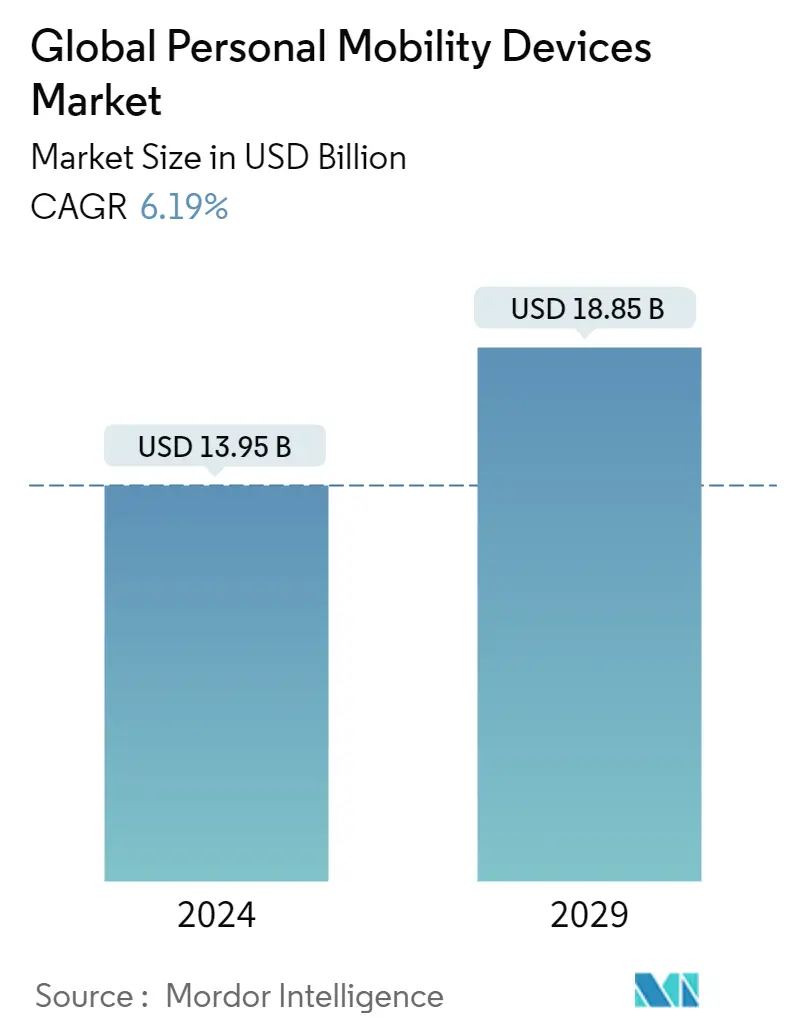Market Size of Global Personal Mobility Devices Industry

| Study Period | 2019 - 2029 |
| Market Size (2024) | USD 13.95 Billion |
| Market Size (2029) | USD 18.85 Billion |
| CAGR (2024 - 2029) | 6.19 % |
| Fastest Growing Market | Asia Pacific |
| Largest Market | North America |
Major Players
*Disclaimer: Major Players sorted in no particular order |
Need a report that reflects how COVID-19 has impacted this market and its growth?
Personal Mobility Devices Market Analysis
The Global Personal Mobility Devices Market size is estimated at USD 13.95 billion in 2024, and is expected to reach USD 18.85 billion by 2029, growing at a CAGR of 6.19% during the forecast period (2024-2029).
Many people with chronic conditions or people with physical disabilities are not able to follow the guidelines and procedures to reduce the spread of COVID-19. For example, complete isolation may not be possible for a person with a disability because you need help from home helpers or caregivers. If the outbreak becomes more severe in the area, those services may be disrupted as the attendants become ill themselves. Some may not have access to affordable travel and may have to rely on mobility devices to continue receiving medications or making purchases.
The pandemic has a significant effect on the market as the epidemic has disrupted and can continue to disrupt the performance of the major manufacturers and can have a significant effect on the business and financials of the market, including the ability of end-users to gain access to products.
The major factors contributing to the growth of the market are the increasing number of disability cases due to the growing elderly population, an increasing number of road accidents, spinal cord injuries, and meningitis.
According to the revised World Population Prospects by the United Nations 2020, the number of people aged 60 years or above is expected to grow more than double by 2050, from 962 million in 2015 to 2.1 billion by 2050 worldwide. This age group is at high risk for various age-related illnesses, which require the help of personal mobility. According to Disabled World, currently, about 10% of the world's population, or nearly 650 million people, are living with a disability. In most OECD countries, females have higher rates of disability than males, and according to the UN Development Program (UNDP), 80% of persons with disabilities live in developing countries.
As per the Bureau of Transportation Statistics 2020, the US Department of Transportation, an estimated 25.5 million Americans had disabilities, which made traveling outside the home difficult for them. The geriatric population is more prone to mobility diseases, which is anticipated to lead to market growth.
Continuous evolution and advancement in personal mobility devices have taken place for centuries. Wheelchairs have more robust wheel design and movement capabilities, and the following models continuously shift toward weight reduction and increased maneuverability and performance. There are many companies that offer advanced technological wheelchairs. For example, Invacare Corporation offers power wheelchairs (Storm Series, TDX Series, etc.) starting from USD 5,970.
Growing R&D programs by key players to solve issues and develop products are expected to propel the growth of the market. In November 2019, Arjo acquired substantial equity in Atlas Lift Tech, which is involved in the deployment and management of comprehensive mobility programs through its innovative Lift Coach Model and Mobility Tracking Software Platform.
